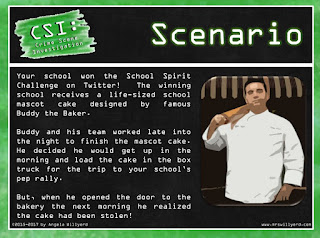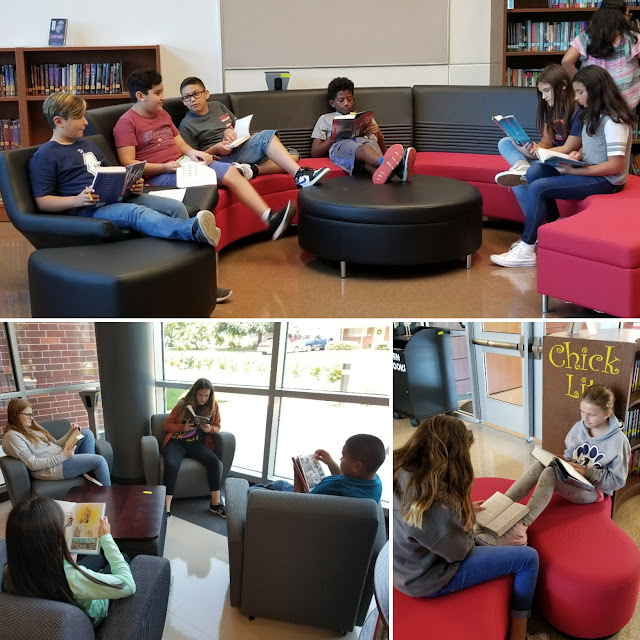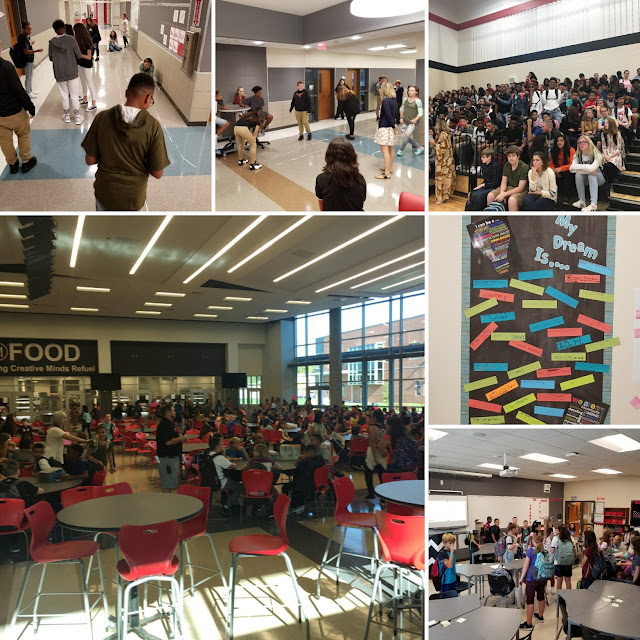- STEM: Problem-Based Learning
- Rigorous & Relevant Instruction: Unpacking the TEKs
- BOLD Literacy: Book Talk - Scythe by Neal Shusterman
The second six weeks has officially arrived, bringing with it fall decorations, lots of rain, and continued learning and instruction here at NRMS. Check out some of the great things happening and maybe even find a few ideas for yourself and your classes.
Falcon Focus: Problem-Based Learning in the STEM Classroom
One key area of focus for STEM (Science - Technology - Engineering - Math) is the Problem-Based Learning model. During the first six weeks, 7th grade science students tackled a PBL that challenged the students to learn about physical and chemical changes by solving a mystery. (6.5D I can identify the formation of a new substance by using the evidence of a possible chemical change such as production of a gas, change in temperature, production of a precipitate, or color change.
The "problem" for the 7th graders? A giant cake had gone missing, and it was up to the students to utilize their knowledge and observations of physical and chemical changes to identify the "mysterious white substance" and correctly match it with a suspect.
Students made predictions and recorded their observations as they tested the various powders, leading up to a final analysis of their results to identify the culprit.
Falcon Focus: Unpacking the TEKs
Our Texas Essential Knowledge and Skills, or TEKs, guide us in planning at the right rigor and relevance levels for our students' learning; but did you realize that our standards can also be a foundational learning tool for your students?
It's important for our students to process what they're learning and to develop their metacognative skills (thinking about their thinking). Explicitly unpacking the TEKs does this by making the content and skills relevant to them. "The state of Texas says we have to learn this - so what does that really mean?" By closely examining the TEKs with our students, we are able to point out essential academic vocabulary. Our discussions can be turned into valuable anchor charts and elements of a word wall.
For additional information and examples, check out the resources below.
 Falcon Focus: Book Talk - Scythe by Neal Shusterman
Falcon Focus: Book Talk - Scythe by Neal Shusterman
Finally, time for your regularly scheduled book talk. This one is brought to you by Kathy Harvell.
Scythe is the first novel in a series by Neal Shusterman. It is also on the Texas Star Reading List. It may be your new favorite book!
Hear from Kathy below.
Falcon Focus: Problem-Based Learning in the STEM Classroom
One key area of focus for STEM (Science - Technology - Engineering - Math) is the Problem-Based Learning model. During the first six weeks, 7th grade science students tackled a PBL that challenged the students to learn about physical and chemical changes by solving a mystery. (6.5D I can identify the formation of a new substance by using the evidence of a possible chemical change such as production of a gas, change in temperature, production of a precipitate, or color change.
7.6B I can distinguish between physical and chemical changes)
 |
| The entry documents for this PBL |
The "problem" for the 7th graders? A giant cake had gone missing, and it was up to the students to utilize their knowledge and observations of physical and chemical changes to identify the "mysterious white substance" and correctly match it with a suspect.
Students made predictions and recorded their observations as they tested the various powders, leading up to a final analysis of their results to identify the culprit.
 |
| STEM learning challenges students to make predictions in order to pull them into the learning process. |
 |
| Students carefully test the samples to try to determine their identities and match them to the crime scene "evidence". |
Falcon Focus: Unpacking the TEKs
 |
| Robin Asaff leads her students in unpacking the TEKs. |
It's important for our students to process what they're learning and to develop their metacognative skills (thinking about their thinking). Explicitly unpacking the TEKs does this by making the content and skills relevant to them. "The state of Texas says we have to learn this - so what does that really mean?" By closely examining the TEKs with our students, we are able to point out essential academic vocabulary. Our discussions can be turned into valuable anchor charts and elements of a word wall.
 |
| Students create a similar TEK dissection in their journals, where they can individualize their notations to deepen their understanding. |
 |
| 7th grade math will use this guide to support students in their upcoming PBL. |
For additional information and examples, check out the resources below.
- Unpacking the Standards (Slideshare) - https://www.slideshare.net/sknight/unpacking-standards
- TEK Breakdown in Science (YouTube) - https://www.youtube.com/watch?v=v4Op2TxSwss
- Unpacking the Standards (YouTube) - https://www.youtube.com/watch?v=OYprTv90avQ
 Falcon Focus: Book Talk - Scythe by Neal Shusterman
Falcon Focus: Book Talk - Scythe by Neal Shusterman Finally, time for your regularly scheduled book talk. This one is brought to you by Kathy Harvell.
Scythe is the first novel in a series by Neal Shusterman. It is also on the Texas Star Reading List. It may be your new favorite book!
Hear from Kathy below.
If have any questions or would like some help implementing these or other strategies, please let me know. And remember...
It's a great day to be a Falcon!







































